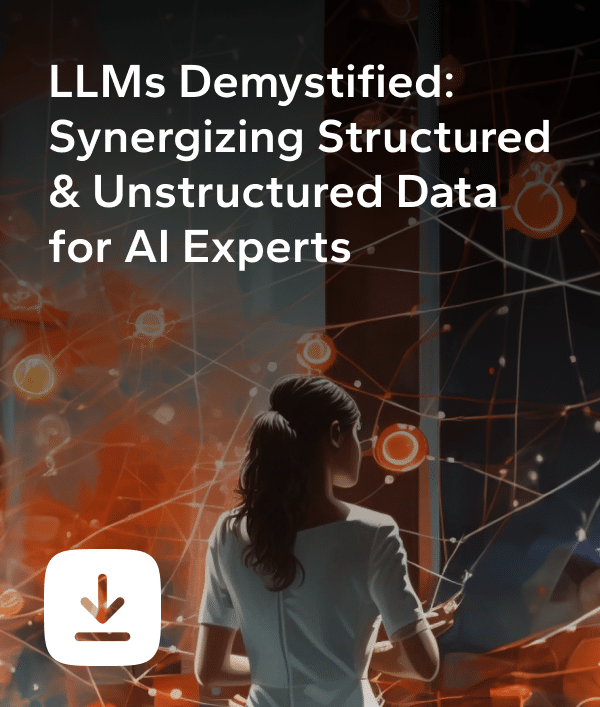Businesses face an overwhelming amount of data rich with insights to unlock. Traditional keyword-based searches have long been the go-to method for wading through this informational deluge, but as the complexity and volume of data expand, the inefficiencies of such systems become more apparent. This is where Generative Question Answering represents a seismic shift in the way we interact with data. It promises a solution that’s not just effective, but also intuitively aligned with our inquisitive human nature.
Powered by the latest advancements in Large Language Models (LLMs), Generative Question Answering tools are revolutionizing the question-answering experience. Instead of simply matching keywords, these systems understand context, interpret nuances, and generate rich, coherent responses that get to the heart of what we’re searching for. It’s the difference between the staccato of a typewriter and the fluid eloquence of a human conversation.
This innovative approach is changing the game for businesses and the way they process, search, and extract meaning from their ever-growing structured and unstructured data repositories.
Advancement in Question Answering: Breaking Free from the Keyword Chains
The keyword search—a digital staple that has been with us since the advent of the web—has, to date, stood the test of time. But, in its rigidity and lack of nuance, it is often akin to finding a book in a library by searching only the titles—effective to a point, but sorely lacking the importance of context.
LLMs have introduced a novel way of searching that feels more like asking a learned colleague a question; it’s intuitive, dynamic, and contextually aware.
The core strength of LLMs is their profound capacity to interpret and process human language with remarkable accuracy. These models go beyond simply identifying pertinent documents or text excerpts in response to search inquiries. They are designed to comprehend the context and implications of questions, thereby providing comprehensive and more relevant responses.
This significant advancement marks a paradigm shift, effectively eliminating the rigidity of keyword searches and introducing a dialogue-based interaction that mirrors human conversation.
LLMs employ deep learning to process extensive textual data, attaining a rich contextual understanding well beyond mere word recognition. They analyze language patterns and structures to perform complex semantic analyses, capturing nuanced meanings and interpreting expressions like sarcasm and idioms. With the capability for continuous learning, LLMs consistently refine and enhance their linguistic proficiency, outpacing traditional static keyword-based systems in understanding and emulating human communication.

Why Generative Question-Answering Represents a Paradigm Shift
Interactive Experience in Generative QA
Generative Question Answering alters the user experience from a simple input-output transaction to a sophisticated conversational engagement. With LLMs, users are no longer limited to rigid query syntaxes; they can pose questions as they would to another human. This human-like interaction is not only more natural but also allows for clarification, refinement, and follow-up questions, thereby creating an adaptive and interactive session that feels less like querying a database and more like a dialogue.
Enhanced Accuracy through Contextual Understanding
The precision of responses in Generative Question Answering is elevated by the LLMs’ deep contextual understanding. Unlike traditional systems that often return irrelevant results due to the literal interpretation of keywords, LLMs discern the intent behind queries. This reduces the time spent sifting through inaccurate or irrelevant information and enhances the quality of outcomes. Decision-makers armed with precise, contextually relevant information are better positioned to make informed decisions quickly, a crucial benefit in strategic business contexts where accuracy and speed are paramount.
Innovation in Data Processing and Retrieval
By pushing the boundaries of traditional information retrieval methods, LLMs serve as the vanguard for innovative data processing technologies. This allows for the development of advanced search and analysis tools that align closer with human cognitive processes than ever before. Businesses equipped with these tools can unlock insights from massive, complex datasets with unprecedented efficiency. This innovation goes hand in hand with the growing need for companies to harness both structured and unstructured data for competitive advantage, establishing Generative Question Answering as a critical facilitator of knowledge discovery in an increasingly data-centric corporate landscape.
Differentiation Among LLMs in Understanding Human Language
LLMs’ deepened understanding of human language not only enhances the user experience but also provides businesses with powerful tools to sift through data more meaningfully. As various types of LLMs emerge, each with its specialized capabilities, the potential for tailored, sophisticated language understanding grows, marking a turning point in AI’s role in business intelligence and operations.
Architectural Distinctions Among LLMs
The proficiency of LLMs in comprehending human language is significantly influenced by their underlying architectures. Transformational architectures such as those in OpenAI’s GPT series or Google’s Gemini utilize distinct neural network configurations, which determine their language processing abilities. These technological variations often lead to divergences in understanding context, inferring meaning, and generating responses. Businesses must therefore consider the underlying architecture of an LLM when assessing its suitability for their specific data interrogation needs, as the choice of model could greatly impact the efficiency and effectiveness of their question-answering capabilities.
Influence of Training Data on LLM Specialization
The depth and breadth of an LLM’s language understanding are considerably shaped by its training datasets. If an LLM is trained on rich and varied data sources, it becomes more adept at handling a wide range of language nuances and industry jargon. Conversely, models trained on more targeted datasets may develop a niche expertise, becoming highly proficient in specific domains or languages. Decision-makers are tasked with selecting LLMs whose training aligns with their operational needs, thus maximizing the relevance and utility of the insights garnered from data interactions.
Specialization through Purpose-Built LLMs
As businesses strive for precision in data analysis, the emergence of purpose-built LLMs signifies an important evolution. These models are meticulously fine-tuned for particular applications such as legal or medical language analysis, offering an enhanced capacity for understanding and responding to queries within those contexts. The specialized knowledge and tailored response generation this affords can be invaluable for organizations requiring accurate information within specific sectors. The strategic deployment of such models represents a significant step forward in leveraging AI for domain-specific intelligence and operational excellence.
The Technical Mechanism of Generative Question Answering Systems
The technical backbone of these Generative Question Answering systems begins with the aggregation and preparation of documents, where data in various forms is parsed and chunked into digestible pieces. Next, each section of text is embedded into numerical vectors through advanced NLP techniques, forming a tapestry of indexed data that the LLM can efficiently navigate.
This convergence of AI and database technologies enables rapid and efficient information retrieval, akin to how a subject matter expert might recall and apply knowledge when posed with a question. The Generative Question Answering system retrieves the most relevant context and the LLM weaves it into a coherent, insightful answer. This process mirrors a human-inspired way of understanding and is the cornerstone of the Generative Question Answering approach.
Key Applications of GQA: The Frontier of Intelligent Data Interactions
Generative Question Answering’s versatility extends across numerous applications where information retrieval and processing are essential. Consider the potential within the legal sphere, where analyzing vast compendiums of case law, precedents, and legal texts becomes a task executed with laser precision. Or in healthcare, where parsing through patient records, research papers, and treatment databases can now be done with the same care and consideration that a seasoned medical professional might exhibit.
These practical applications demonstrate that Generative Question Answering is not simply a tool; it’s a multiplier of human capability—an extension that enables us to interact with data like we would a human expert. By turning information retrieval into an intelligent dialogue, Generative Question Answering is equipping businesses with the capability to leverage their data in ways that drive innovation, sharpen competitive edges, and facilitate growth like never before.

Addressing the Complexities and Challenges of Generative Question Answering
As with any groundbreaking technology, the path forward for Generative Question Answering is not without its challenges. Ensuring the accuracy and reliability of responses, particularly in scenarios where erroneous information can have serious consequences, remains a paramount concern.
The computational demand and associated costs of running such sophisticated models must be strategically managed to balance performance with profitability. And as these systems rely on extensive training and data sources, avoiding the pitfall known as ‘model hallucinations’—where the AI confidently presents incorrect information as fact—requires vigilance, strategy, data preprocessing and robust engineering.
Data Security and Privacy in Generative Question Answering
In the domain of Generative Question Answering, data security and privacy stand as paramount concerns. Given the extent to which these systems interact with sensitive and confidential information, rigorous data governance and strict adherence to compliance regulations are essential.
The Imperative of Data Governance in Generative Question Answering
Robust data governance is critical in Generative Question Answering to manage risks effectively. Implementing comprehensive frameworks helps safeguard against data breaches and misuse of sensitive information. Companies must construct and enforce strong governance policies to navigate the balance of data utility and security. This foundation provides a bulwark against both internal and external threats that could undermine the integrity and the value of the business’s data assets.
Control Mechanisms in Generative Question Answering
Control mechanisms are the linchpins of data security within Generative Question Answering systems. By ensuring that sensitive data is accessible only to authorized users, a company can significantly mitigate the risks associated with data mismanagement. These control measures form an essential layer of defense, fortifying data repositories against potential compromises and reinforcing the overall security posture of an organization’s data-driven initiatives.
Ensuring Compliance in Generative Question Answering
Compliance with GDPR, HIPAA, and other regulatory mandates is indispensable for Generative Question Answering systems. Adhering to these laws helps organizations avoid considerable legal and financial repercussions. Equally important is the implementation of meticulous audit trails that record data usage and access. These logs are critical tools to ensure and demonstrate regulatory compliance, fostering transparency and accountability within complex data ecosystems.
Privacy by Design in Generative Question Answering Systems
Instituting privacy by design within Generative Question Answering solutions means data privacy considerations are embedded directly into system architectures. This proactive strategy is far superior to retrofitting privacy measures and emphasizes data minimization, ensuring only essential data is collected and processed. This approach is not just about compliance; it’s about respecting user privacy and securing the trust of stakeholders by acknowledging the critical importance of data protection from the ground up.

Securing Generative Question Answering Infrastructure
Encryption is the cornerstone of securing data within Generative Question Answering systems, safeguarding information at rest and in transit from unauthorized infiltration. Moreover, deploying techniques like anonymization and pseudonymization fortifies the confidentiality of personal identifiable information (PII), aligning with stringent privacy standards. These security measures are non-negotiable in today’s cyber landscape where data breaches can have far-reaching and irreversible consequences.
Integrating these robust security and privacy controls into Generative Question Answering systems is not just a technical necessity; it is a strategic imperative that reinforces user trust and ensures the ethical handling of data. As businesses increasingly rely on these advanced AI tools for critical operations, the commitment to secure and responsible data practices becomes integral to harnessing the transformative potential of generative question answering.
The Path Forward
Generative Question Answering technology heralds a transformative epoch in information retrieval. It’s an inflection point for businesses that see the value in data and understand the power of engaging with it intelligently. As we pioneer this terrain, adopting Generative Question Answering represents more than an upgrade to existing systems—it’s an embrace of a future where data interaction is as fluid, insightful, and intuitive as a dialogue between experts.
As businesses grapple with dynamic markets and the ceaseless influx of information, orienting their strategies to incorporate Generative Question Answering is not just an option, but an imperative. It is time for organizations to move to a landscape where data is not just retrieved but conversed with, comprehended, and harnessed like never before.




